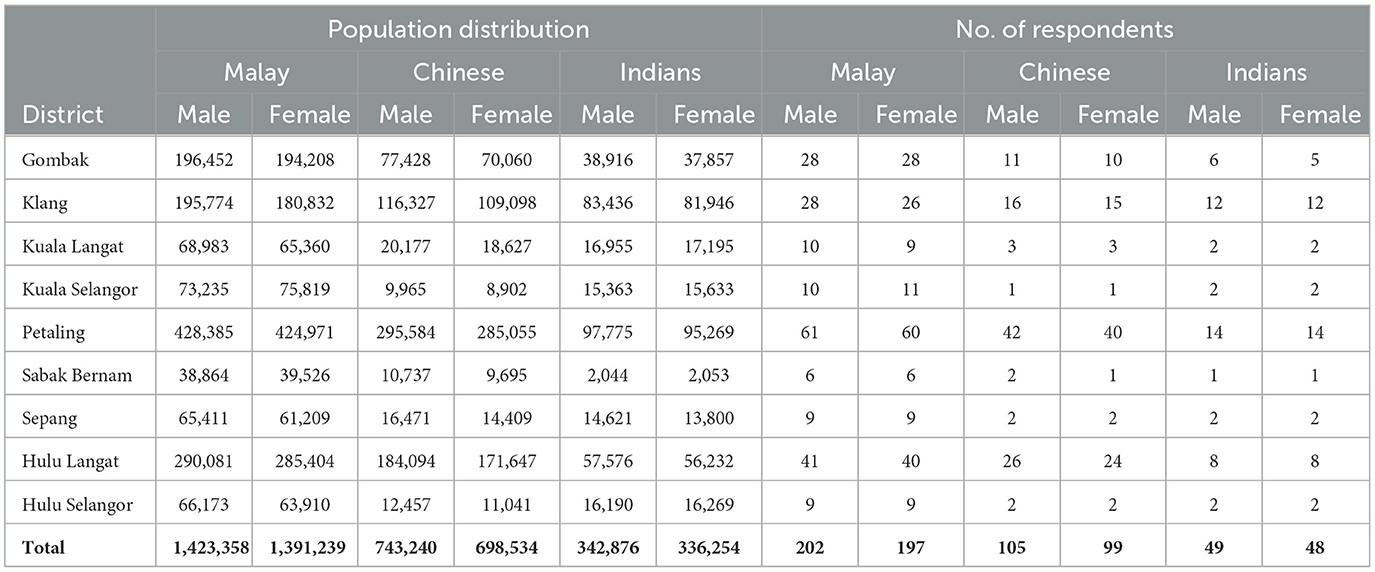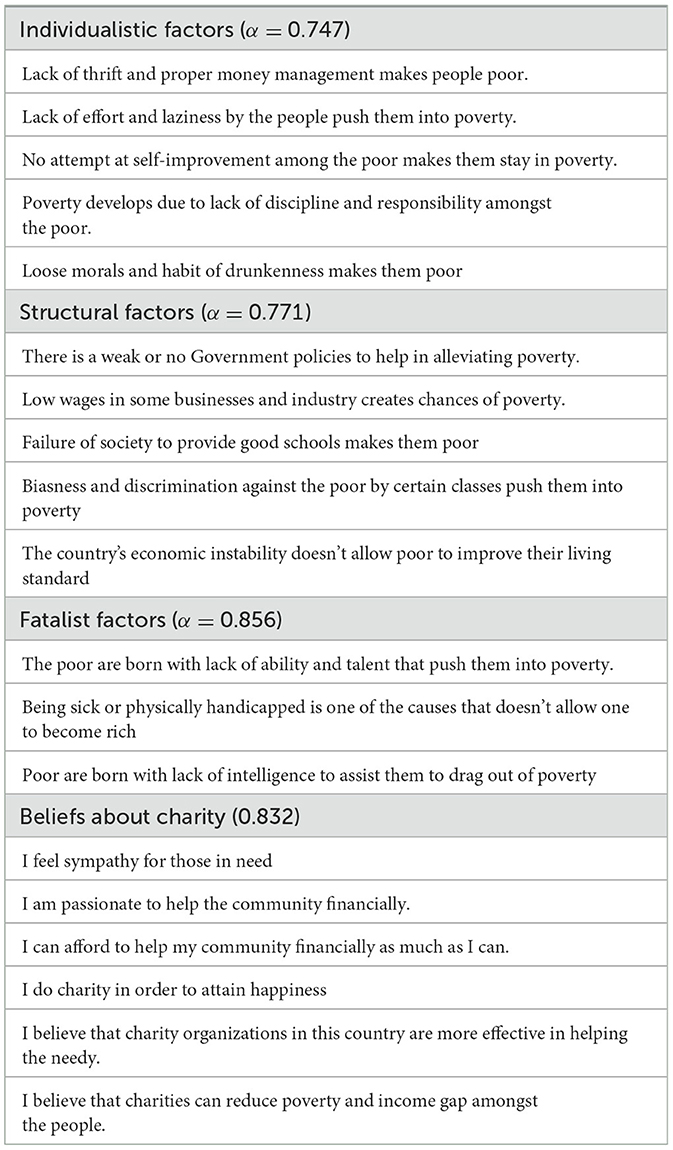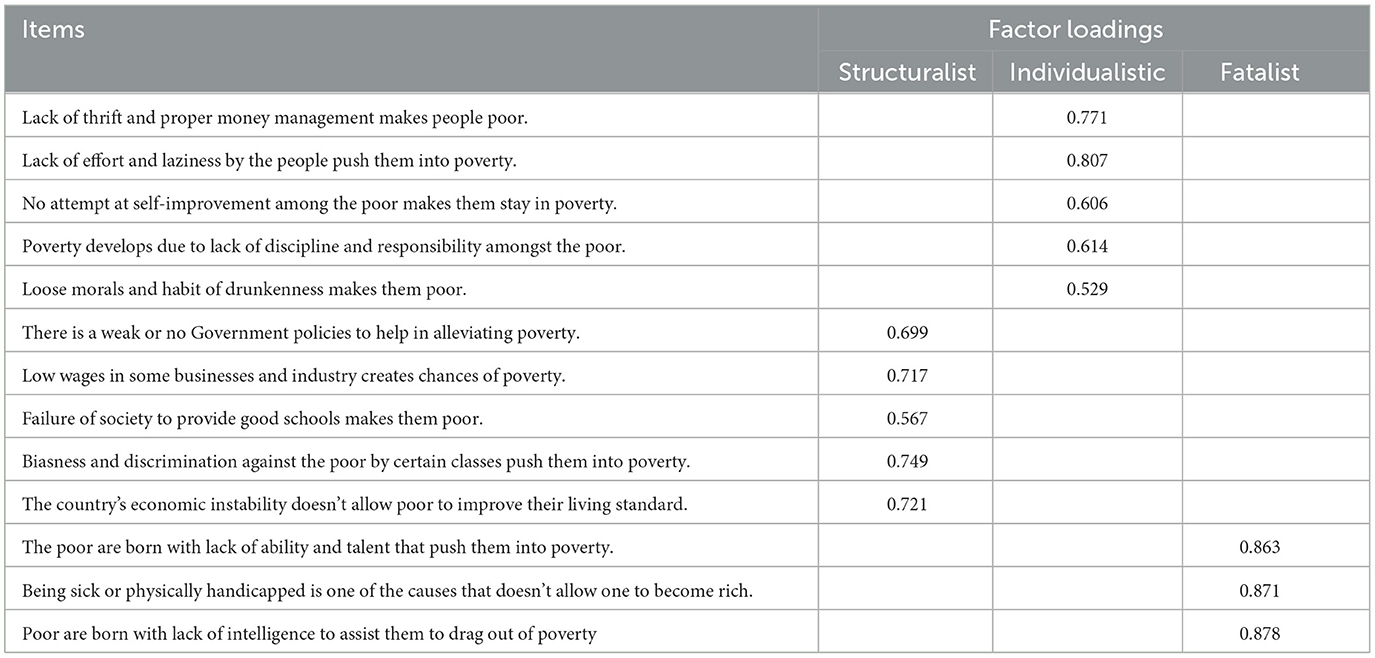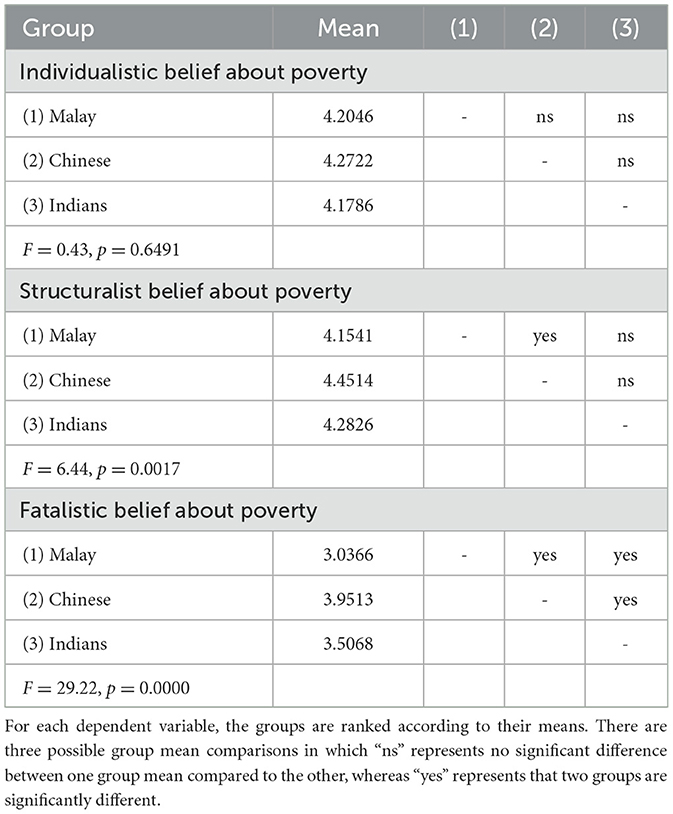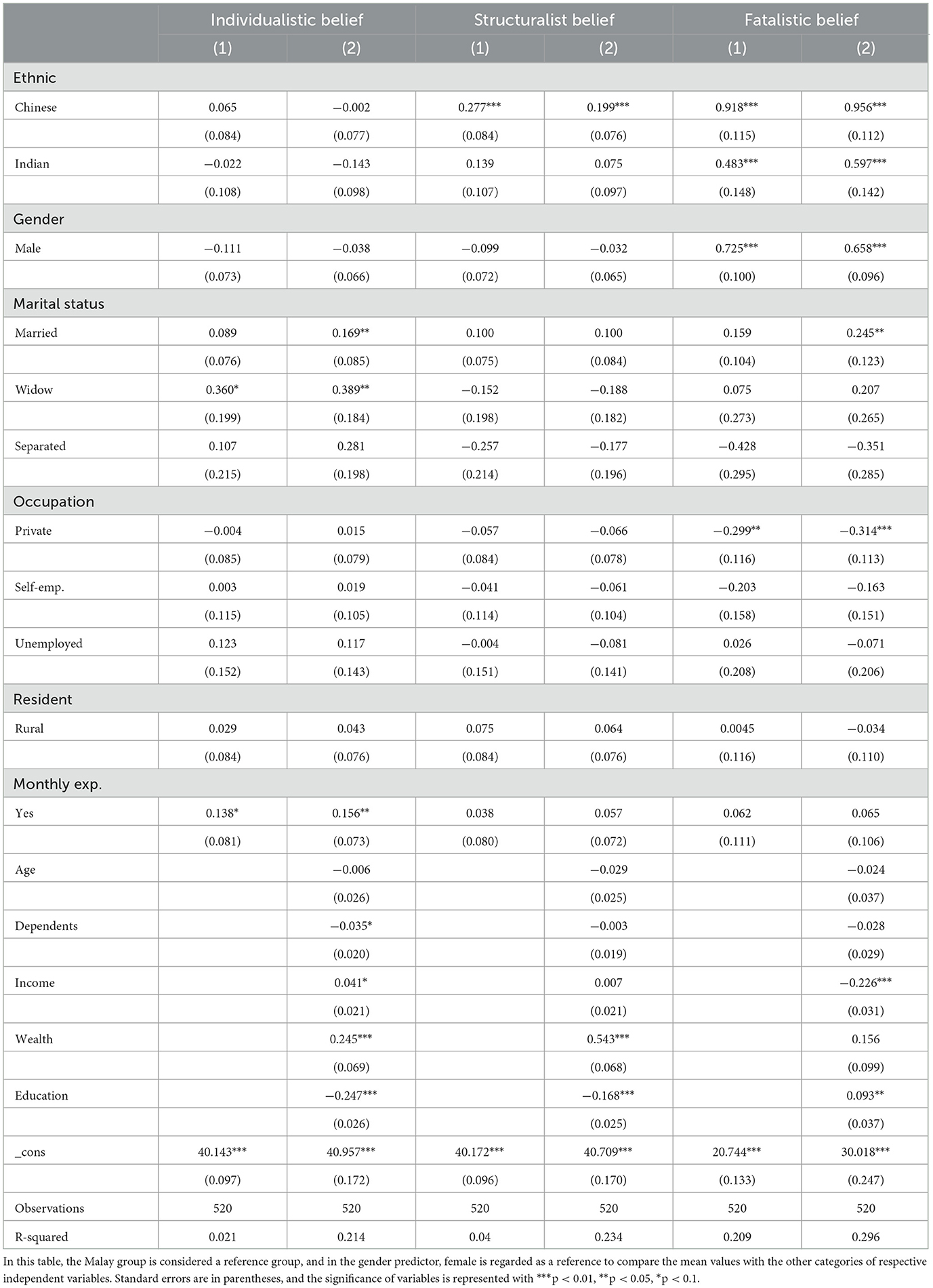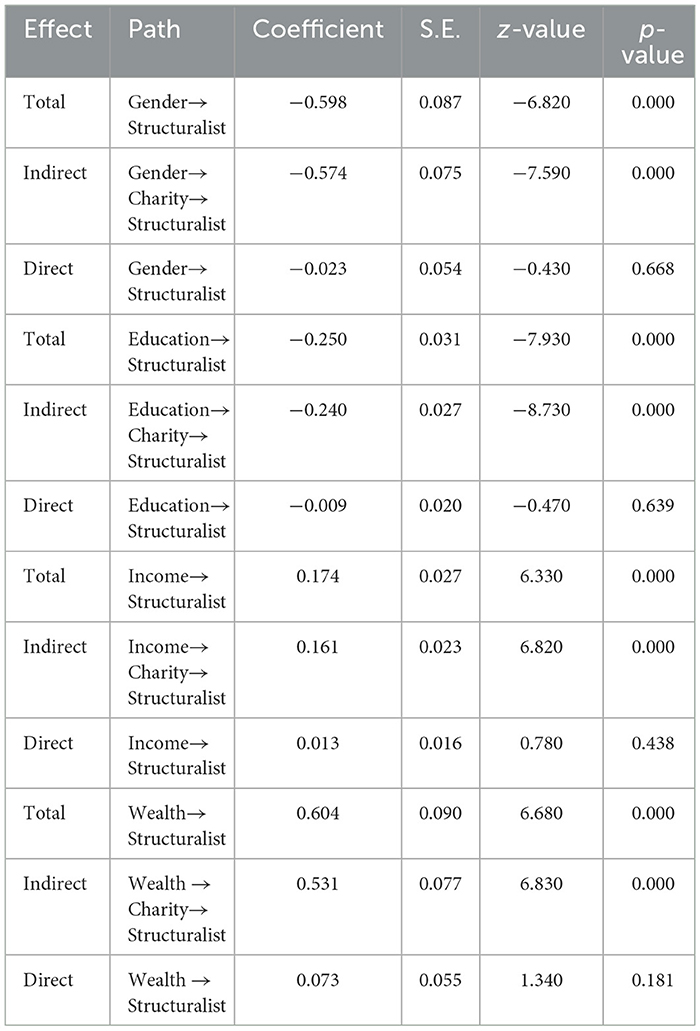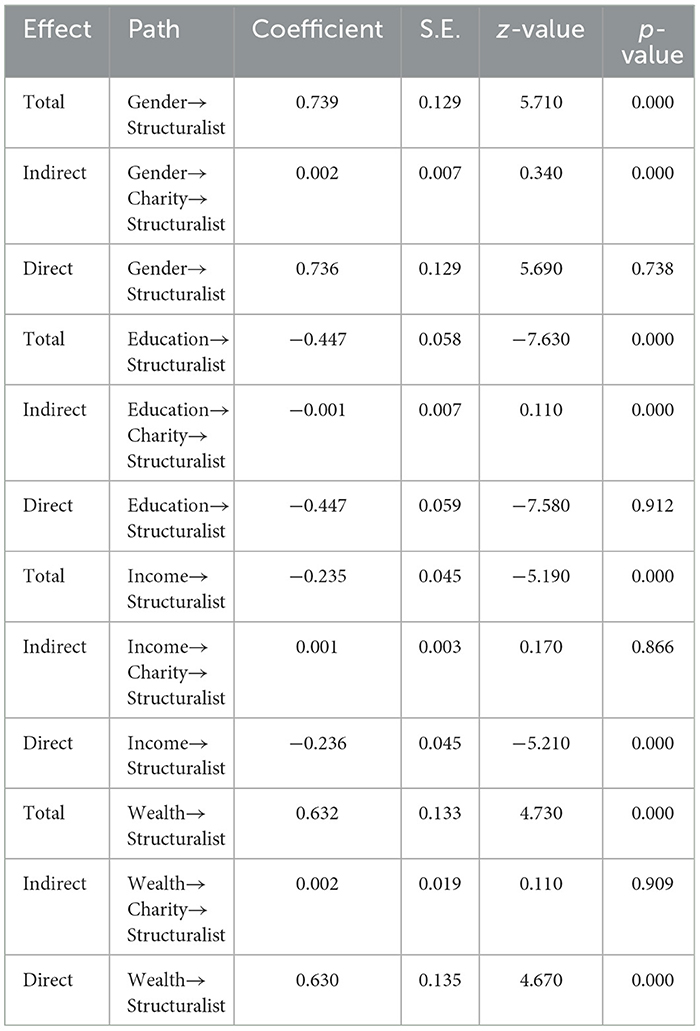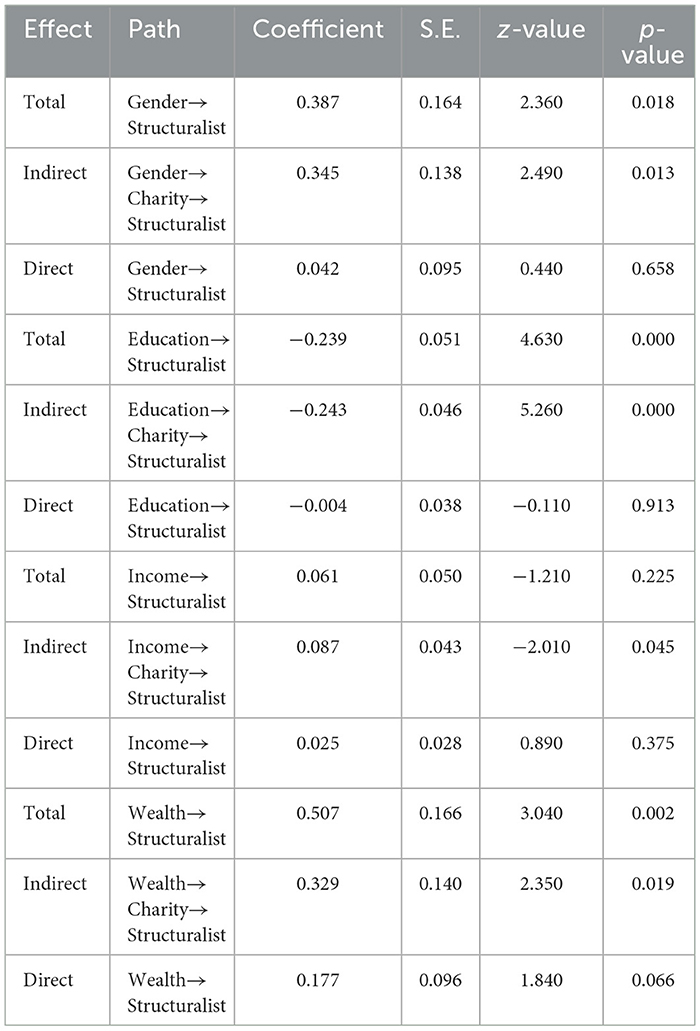- 1Department of Islamic Economics and Finance, Faculty of Political Sciences, Sakarya University, Sakarya, Türkiye
- 2Faculty of Economics and Management, National University of Malaysia, Bangi, Selangor, Malaysia
- 3Department of Business Administration, Sukkur IBA University, Sukkur, Sindh, Pakistan
- 4Department of Economics, College of Business Administration, King Saud University, Riyadh, Saudi Arabia
Introduction: Malaysia as an ethnically diverse country has a history of interethnic inequality and poverty which led to the development of different views about the existence of poverty. Among these ethnic groups, some sympathize with the poor and help them through different charity organizations. However, these charity organizations are mostly unaware of the target donors that can aid their charity funds. Therefore, this study explores the attitudinal differences regarding poverty among Malays, Chinese, and Indians and the demographic groups that can be targeted for donation and social policy development purposes.
Methodology: A survey is conducted in Selangor, where the data through a questionnaire is extracted from the three ethnic groups. Through the quota sampling technique, a sample of 700 is derived. The results are analyzed through ANOVA, regression, and mediation analysis.
Results: The results show that attitudinal differences between Malays and Chinese regarding structuralist beliefs could be observed. Moreover, among Malays, it is found that the relationship between gender, income, education, wealth, and structuralist beliefs is significantly mediated by beliefs about charity. On the other hand, mediation analysis for Chinese identifies gender, education, and income while among Indians gender, education, and wealth are identified as key demographic groups.
Discussion: This study highlights the role of attribution theory to identify the charity donors among the different ethnic groups which was overshadowed by the previous research in Malaysia. The results also hold significance for charity institutions to target the specified groups through their marketing campaigns. Also, based on these results government can reduce the misconception about the existence of poverty and to develop policies that encourage high income groups to support the poor.
Introduction
Economic disparities between Malaysia's main ethnic groups have existed since British rule and intensified after independence in 1957. Poverty was more prevalent among Malays, primarily in agriculture (Abid et al., 2018), while the Chinese benefitted from control over tin mines (Altas, 1977). Educational inequality emerged post-independence, adding to economic imbalances (Saniman, 2007). Pro-poor policies failed to alleviate Malay poverty, leading to growing discontent, which culminated in ethnic riots following the 1969 election. A national emergency ensued, and a caretaker government introduced the New Economic Policy (NEP) in 1971 (Faaland et al., 1990). This ethnic-based affirmative policy aimed to reduce inter-ethnic income inequalities, primarily benefiting Malays through civil sector quotas and education quotas (Ravallion, 2020; Asadullah et al., 2023). While NEP reduced inter-group inequality, it increased intra-group disparities among Malays (Ravallion, 2001; Khalid, 2014).
To address intra-group inequalities, Malays utilized charities such as sadaqah, zakat, and cash waqf. Similarly, Chinese and Indian communities operated charitable foundations to assist low-income members. However, apart from the government's BSHR scheme targeting low-income groups, most charitable institutions rely on public donations and face challenges in identifying potential donors. Cash waqf, for instance, has been instrumental in human development for the bottom 40% of Malays, where waqif (donors) contributes funds that are managed and invested by a mutawalli (manager) according to Islamic principles (Haron et al., 2016; Ali and Markom, 2020; Khan et al., 2022; Amin et al., 2024). Similarly, zakat is an obligatory charity (similar to wealth tax) where the one with wealth equivalent to a certain limit is eligible to donate 2.5% of the total wealth to the specific beneficiaries defined in the Qur'an.
Despite the good intentions, these institutions face significant inefficiencies due to poor database management and limited identification of potential donors. Similar financial constraints affect non-profit organizations supporting low-income Chinese and Indians, who rely heavily on small donor bases within their ethnic communities (Farouk and Wing, 2019; Ab Samad and Ahmad, 2021).
To address the issues, this study contributes to the current research on poverty in Malaysia in two ways which are ignored by the previous research studies in the same area. First, this study examines the attitudinal differences in poverty among the ethnic groups that have been ignored in the previous studies conducted in Malaysia. Second, this study aims to identify those demographic groups in different ethnic groups that can be targeted for charity campaigns by charity organizations. Therefore, to identify the key donors for charity institutions, it is important to know their attitude toward the poor. In social psychology, the attribution theory of poverty asserts that human beings associate different causes with the condition of the poor. Hence, the framework of this study is inspired by the attribution theory of poverty to identify those individuals who associate structuralist views about poverty.
Attribution theory of poverty
The attribution theory of poverty has been a significant focus of academic inquiry, particularly from the 1970's to 2010. However, the research is further scant in the later years on this topic. Nevertheless, this study attempts to explore the most relevant literature on the theory, focusing on how demographic groups can be targeted for charitable purposes by examining their beliefs about poverty and charity.
Initially, Simmel (1908), cited in Oorschot and Halman (2000), argued that beliefs about poverty shape welfare policies, with public attitudes determining whether poverty is an individual or societal issue. In the 1970's, studies (Alston and Dean, 1972) found that white Americans predominantly blamed the poor for their circumstances, with younger and more educated respondents being less sympathetic. The attribution theory, developed by Heider (1958), categorizes explanations of behavior into internal (personal) and external (situational) factors, later linked to poverty by Feagin (1972). Feagin identified individualistic, structural, and fatalistic explanations for poverty.
Subsequent research has expanded on these ideas. Feather (1974) found that low-income Australians attributed poverty to societal factors. Furnham (1982) revealed that Labor Party supporters blamed societal factors, while conservatives pointed to individualism. On the other hand, race influences poverty attributions as the difference of opinion could be observed between different races in the United States of America (Hunt, 1996, 2002, 2004, 2016; Bastias et al., 2024). Similar patterns were observed in Russia and Estonia during economic downturns (Stephenson, 2000). Therefore, the first hypothesis of this study is:
H1: There is a significant difference in the attitude of Malays, Chinese, and Indians regarding poverty.
Sociodemographic factors have a significant impact on the beliefs about poverty (Hunt, 1996; Bastias et al., 2019). Different demographic factors are tested against the individualistic and structural explanations of poverty. For instance, a study conducted in Malaysia finds that younger adolescents tended to blame societal factors for poverty, while older ones held both individualistic and structural beliefs (Halik and Webley, 2011), and a similar pattern could be found in the other countries (Bergmann and Todd, 2019; Alcañiz-Colomer et al., 2023). Similarly, women were more likely to endorse individualistic explanations (Halik et al., 2012) contrasting with earlier findings (Kluegel and Smith, 1986; Hunt, 1996, 2004). However, in some recent studies, it is found that women give structural explanations of poverty as compared to their male counterparts (Terol Cantero et al., 2023). Similarly, Khan et al. (2022), in the context of Malays, found that women with structuralist views are more philanthropic, highlighting the role of beliefs in shaping pro-poor attitudes. Therefore, this study hypothesizes that:
H2: Sociodemographic factors have a significant impact on Individualistic beliefs about poverty.
H3: Sociodemographic factors have a significant impact on structural beliefs about poverty.
H4: Sociodemographic factors have a significant impact on fatalist beliefs about poverty.
Additionally, to answer the second objective of the study, this research sheds light on how these beliefs influence people's willingness to help those experiencing poverty. For example, research shows that individuals who attribute poverty to individualistic factors tend to oppose pro-poor policies, whereas those who endorse structural explanations of poverty are more sympathetic toward the poor and favor such policies (Feagin, 1972; Feather, 1974). Similarly, Tuennerman-Kaplan (2001) suggests that people with structural beliefs about poverty are likelier to engage in philanthropy. However, previous studies have not provided empirical evidence to support these claims. This gap is addressed by Khan et al. (2022), who found that women are more likely to hold structuralist views, with their philanthropic nature being a key factor behind this perspective. They also identified the sociodemographic groups who have positive opinions about poverty. However, the study is limited to the Malays ethnic group only. Therefore, this study focuses on inter-ethnic comparison where beliefs about charity mediate the relationship between sociodemographic factors and structural beliefs about poverty.
H5: Beliefs about charity mediate the relationship between sociodemographic factors and structural beliefs about poverty.
To achieve the objectives of this study, the next section presents the methodology, detailing the sampling size and the development of the questionnaire. Following this, the results are reported in the finding section and contextualized within the discussion section. Finally, the conclusion provides a summary of the findings, highlights the study's limitations, and discusses its implications.
Methodology
Sampling
This study uses a non-probability sampling technique due to the non-availability of proper databases and limited resources. Selangor is selected as a sample because of its diverse population and the non-probability sampling technique is used to select the respondents for the study. Next, a sample size of 384 is identified based on Krejicie and Morgan's sample size table (Krejicie and Morgan, 1970); however, around 700 questionnaires were distributed.
The quota sampling technique is then applied, dividing the sample into nine districts. To reduce sample bias, first, the sample is categorized based on the population of Malays, Chinese, and Indians in Selangor and then further classified into males and females of each ethnic group. The details regarding sample distribution can be seen in Table 1.
The data was collected by approaching the respondents personally. The respondents were informed about the purpose of data collection and their consent was taken before handing over the questionnaire. Later, the incomplete and unfilled questionnaires were discarded, and 520 responses were retained for final analysis.
Questionnaire and measurement
The questionnaire for this study is adapted from the Khan et al. (2022) study. In their research, four of six independent variables are adopted from previous studies such as Hunt (1996, 2002, 2004), while the authors introduce two. This study considers 11 sociodemographic factors (independent variables) to cover the broader perspective. The factors include ethnicity, gender, marital status, occupation, residence, monthly expenditure, age, dependents, income, wealth, and education.
The dependent variables in their study, i.e., structural, individualistic, and fatalist factors, are adopted from Feather (1974), Furnham (1982), Smith and Stone (1989), and Hunt (2004). The responses were measured on the Likert scale of 1 (Totally disagree) to 6 (Totally agree). Next, the study constructed beliefs about charity variables. This variable is used as a mediating variable in their research. In the current study, the same variable is used for mediation analysis. The reliability analysis for these variables based on Cronbach alpha is reported in Table 2.
Statistical software packages such as SPSS version 20 and Stata version 17 are used to perform the analysis. Due to the extended sample of this study, factor analysis is performed, and the results are extracted using a principal component method with Eigenvalues of >1. Items carrying a factor loading of >0.5 are retained for each dependent variable. The results are reported in Table 3. Moreover, the factor analysis results of the mediating variable are represented in Table 4.
Finding
This section reports the results of the hypotheses of this study. However, before reporting the main findings of this study, descriptive analysis was performed to develop an understanding of the distribution of the sample of the study. In this regard, Table 5 shows the descriptive characteristics of the sample. Most respondents were Malays, comprising 57.9% of the sample, followed by Chinese (27.7%) and Indians (14.4%). About half of the respondents were married, and approximately the same percentage of respondents were male. Moreover, most respondents had undergraduate degrees (38.7%), whereas about 42.1% had monthly income between RM 2001-4000. The majority had no wealth possession, and most respondents reported a deficit in what they earned and what they spent. Most respondents aged between 25 and 30 years and ~74% lived in Selangor's urban areas. Regarding occupation, half of the sample worked in the private sector at the time of the data collection, and most respondents reported no dependents.
Table 6 presents the results of a one-way analysis of variance (ANOVA) conducted to assess the variations in attitudes toward poverty among various ethnic groups (Fisher 1970). Regarding individualistic beliefs, the Chinese exhibit a higher mean score (4.2722) than other ethnic groups. Nevertheless, no statistically significant difference is observed among the mean scores of all ethnic groups (F = 0.43, p > 0.05). This suggests that these ethnicities share similar beliefs regarding the individualistic aspects of poverty. Regarding structuralist beliefs, the Chinese have the highest mean score (4.4514), signifying their belief that poverty is primarily attributable to a lack of opportunities and external factors. A significant difference is observed between the mean scores of the Chinese and Malays, while Malays and Indians hold similar views about poverty in this context. Whereas, fatalistic beliefs about poverty, there is a substantial difference (F = 29.22, p < 0.01) among the group means of all ethnicities. Compared to Malays, both Chinese and Indians are more likely to endorse fatalistic beliefs about poverty, attributing it to bad luck as a prominent reason. It can also be observed that all ethnicities agree on the existence of poverty due to individualistic factors as well as structuralist factors.
A series of Ordinary Least Squares (OLS) regression models were conducted to test hypotheses 2, 3, and 4, which investigate how different ethnic groups influence views on poverty while controlling demographic factors. The results of these regression models, specifically focusing on individualistic, structuralist, and fatalistic beliefs about poverty, are summarized in Table 7.
Individualistic belief
In the initial model, monthly expenses and marital status were statistically significant at 10%. This suggests that, when comparing Malay, Indian, and Chinese females, there is a modest inclination to believe that poverty is mostly attributed to a lack of education and abilities. However, when demographic factors are considered in the second model of individualistic beliefs, the significance of the coefficients for marital status and monthly expenses has improved. Additionally, inherited wealth substantially impacts the development of individualistic beliefs. Education plays a crucial role in shaping Individuals' perspectives, especially regarding socioeconomic status. Specifically, females with limited educational opportunities who possess inherited wealth tend to adopt more individualistic ideologies that perpetuate the cycle of poverty than males.
Structuralist belief
In the second model of structuralist beliefs, the coefficient for Chinese ethnicity is positively and statistically significant at the 1% level. The coefficient of inherited wealth is also statistically significant at the 1% level. Education has a notable negative impact on structural beliefs. It may be inferred that, when compared to individuals of other ethnic backgrounds, Chinese females with higher levels of education are less likely to support the socioeconomic element as a cause of poverty. On the other hand, women with higher degrees of inherited wealth seem to have a stronger inclination toward embracing the structuralist perspective on poverty compared to men. The predominant tendency is to attribute poverty mostly to societal factors or the absence of income-generating alternatives.
Fatalist belief
In the initial model, when comparing Malay ethnicity to Chinese and Indian ethnicities, the latter two groups exhibit a statistically significant positive influence on fatalistic attitudes at the 1% level. The coefficient of gender shows a positive and statistically significant relationship at the 1% level. Males of Chinese and Indian descent exhibit a higher tendency to endorse fatalistic ideas regarding poverty compared to females. In contrast, the occupation variable shows a significant negative association with fatalistic attitudes at a 5% level. Chinese and Indian males engaged in private-sector employment are less likely to endorse fatalistic beliefs regarding poverty.
After accounting for demographic factors, the second model enhances the relevance of private sector occupation. The analysis reveals a statistically significant association between marital status and fatalistic belief at a 5% level. Married males tend to hold the opinion that certain individuals are predetermined to experience poverty. The data also indicates a statistically significant negative relationship between income and fatalistic thoughts about poverty at the 1% level. This suggests that individuals with lower income levels place greater emphasis on fatalistic beliefs about poverty. The coefficient of education has exhibited a positive relationship in this context, with a significance level of 5%. The presence of inherited wealth significantly positively influences fatalistic beliefs, as determined at a 5% level.
Table 8 explains the role of Charity (the mediator variable M) in the relationship between demographic factors (independent variable X) and structural beliefs about poverty (the dependent variable Y) for the Malay ethnic group. The results show that the total and direct effects of gender on the structuralist belief about poverty are insignificant, respectively. However, when we included charity as a mediating variable in our model, the relationship between gender and structuralist belief became significant. Thus, the indirect effect of gender on structuralist beliefs through charity is statistically significant. These findings indicate that gender does not directly affect the structural belief about poverty rather, but through charity, it does.
Similarly, the relationship between education and income and structuralist factors and wealth and structuralist factors is also mediated by charity. With increased income levels, Malays become more sympathetic toward the poor because of their philanthropic nature. Conversely, with the decreased education level, Malays have become more sympathetic toward the poor because of their philanthropic nature. The results are aligned with the study of Khan et al. (2022), which suggests that beliefs about charity mediate the relationship between these variables.
Table 9 shows the mediation analysis results for the Chinese ethnic group. The results show that the beliefs about charity mediate the relationship between gender and structuralist beliefs and education and structuralist beliefs. It means that Chinese males are more concerned about people experiencing poverty because of their strong philanthropic beliefs. However, this result contrasts with the Malay group, where the same result holds for the female group. Similarly, the low-level education holders are more concerned about the poor and hold societal factors responsible for poverty because they are more philanthropic.
Table 10 reports the mediation analysis results of the Indian ethnic group. The results show that the relationship between gender, education, income, and wealth with structuralist beliefs is mediated by beliefs about charity. Like the Chinese group, Indian males hold more structuralist views about poverty because of their strong philanthropic beliefs. Also, with a decrease in education level, the structuralist beliefs strengthen due to the strong charitable beliefs of the Indian ethnic group. Like Malays, with the increase in income and wealth, the beliefs of the Indians become more structuralist due to their strong beliefs about doing charity.
Discussion
This study primarily aimed to test the attribution theory in the context of Malaysia and to identify the charity donors for the charity institutions in Malaysia. Therefore, a stepwise approach is used to identify those more sympathetic toward the poor and then identify the sociodemographic groups the charity institutions can target for their campaigns. Hence, to identify the donors based on ethnicity, this study first performed ANOVA analysis and found that all ethnic groups hold similar views regarding individualist and structural beliefs about poverty. Similar results have been achieved by Hunt (2004) which showed that American holds both individualist and structuralist views about poverty. The author termed it as dual consciousness. Similarly, Khan et al. (2022) also report similar patterns among the Malays.
Based on the regression analysis, it is identified that Chinese women with higher levels of education are less likely to suggest structural factors of poverty as the main cause. However, those females with high levels of wealth tend to support that poverty exists because of societal neglect. Further, studies claim that the strength of beliefs about poverty depends on one's tendency toward beliefs about charity. In other words, those who believe that poverty exists because of societal neglect are more likely philanthropic (Feagin, 1972; Feather, 1974; Tuennerman-Kaplan, 2001). The empirical evidence of such claims has been tested in Malaysia and found that Malays hold structural beliefs because of their philanthropic nature (Khan et al., 2022). Therefore, this study tested the mediating role of beliefs about charity on the relationship between the independent variables (sociodemographic factors) and the dependent (structural factors) variables.
This study finds that the relationship between gender, education, income, wealth (independent variables), and structural factors is mediated by beliefs about charity. The results partially align with the claims of Khan et al. (2022) where gender and education were the identified independent factors in mediation analysis. In this study, it is identified that females, those with low levels of education, higher income, and no wealth, could be targeted by charity institutions for their charity campaigns. On the other hand, Chinese male with a lower level of education can be targeted by Chinese charity institutions for their donation campaigns. Like Chinese, Indian males with structural beliefs are more inclined toward charity. Also, like Malays, those with lower levels of education, high incomes, and no wealth could be the key targets of Indian charity institutions in identifying target groups for charity campaigns.
Conclusion
This study guides charity institutions to design marketing strategies by considering the specific demographic groups identified in this study. In this regard, it is identified that all three ethnic groups i.e., Malays, Chinese, and Indians hold the same views about the existence of poverty. Further, it is found that Malay and Indian females, and those with lower education, high levels of income, and no wealth can be the main targets for the charity institutions. On the other hand, Chinese males, and those with lower education are the potential donors for the Chinese charity institutions. The study also holds importance for the government to develop policies that can address the misconception about poverty and pro-poor policies. For instance, the development of educational plans that aim to address the misconception about poverty across all ethnic groups and executed at higher schooling levels. Also, the government can encourage high-income groups by providing incentives to support charity programs that aim at reducing inequality and poverty.
Nevertheless, the study also has some limitations. First, due to no access to a proper database, this study is based on non-probability sampling techniques, which are statistically less sound than the probability sampling technique. Second, due to budget constraints, the data is only collected from one state of the country, i.e., Selangor. Nevertheless, future researchers can develop their sample based on the Household Income and Expenditure Survey Database if they can access it from the Department of Statistics in Malaysia. Moreover, the research on wealth inequality is more eminent in Malaysia nowadays, it is an opportunity for the future researcher to replicate the same study by using attribution theory in the context of wealth inequality. This study also identifies key demographic groups, providing a foundation for further research aimed at developing pro-poor government policies.
Data availability statement
The raw data supporting the conclusions of this article will be made available by the authors, without undue reservation.
Ethics statement
Ethical approval was not required for the study involving humans in accordance with the local legislation and institutional requirements. The studies were conducted in accordance with the local legislation and institutional requirements. The participants provided their written informed consent to participate in this study.
Author contributions
AK: Conceptualization, Data curation, Methodology, Writing – original draft. MS: Conceptualization, Resources, Supervision, Writing – review & editing. GA: Data curation, Formal analysis, Methodology, Writing – original draft. SZ: Investigation, Writing – review & editing. MH: Funding acquisition, Writing – review & editing.
Funding
The author(s) declare financial support was received for the research, authorship, and/or publication of this article. This research was supported by King Saud University under Researchers Supporting Project No. RSPD2025R997.
Conflict of interest
The authors declare that the research was conducted in the absence of any commercial or financial relationships that could be construed as a potential conflict of interest.
Generative AI statement
The author(s) declare that Gen AI was used in the creation of this manuscript. Generative AI is used in introduction part of the paper for improving the structure and clarity only.
Publisher's note
All claims expressed in this article are solely those of the authors and do not necessarily represent those of their affiliated organizations, or those of the publisher, the editors and the reviewers. Any product that may be evaluated in this article, or claim that may be made by its manufacturer, is not guaranteed or endorsed by the publisher.
References
Ab Samad, N. H., and Ahmad, N. H. (2021). Unveiling the challenges faced by non-profit organization in Malaysia. Int. J. Account. Fin. Bus. 6, 225–233.
Abid, A., Shafiai, M. H. M., and Ismail, M. A. (2018). The Malay economy and exploitation: an insight into the past. Pertanika J. Soc. Sci. Human. 2018:26.
Alcañiz-Colomer, J., Moya, M., and Valor-Segura, I. (2023). Not all poor are equal: the perpetuation of poverty through blaming those who have been poor all their lives. Curr. Psychol. 42, 26928–26944. doi: 10.1007/s12144-022-03804-6
Ali, N. A., and Markom, R. (2020). The challenges in implementing cash waqf in Malaysia. J. Contemp. Islam. Stud. 2020:6.
Alston, J. P., and Dean, K. I. (1972). Socioeconomic factors associated with attitudes toward welfare recipients and the causes of poverty. Soc. Serv. Rev. 46, 13–23. doi: 10.1086/642795
Altas, H. (1977). The Myth of the Lazy Native : a Study of the Image of the Malays, Filipinos and Javanese From the 16th to the 20th Century and Its Function in the Ideology of Colonial Capitalism. London: Frank Cass.
Amin, H., Jam, N. S., Ring, P., Suhartanto, D., Mai, M. U., Razak, D. A., et al. (2024). Examining cash waqf from the perspectives of Malaysian actual donors. Int. J. Islam. Econ. Fin. 7, 473–489. doi: 10.18196/ijief.v7i1.21334
Asadullah, M. N., Joseph, J., and Chin, J. (2023). The political economy of poverty reduction in Malaysia. Progr. Dev. Stud. 23, 127–151. doi: 10.1177/14649934231151486
Bastias, F., Cañadas, B., Figueroa, M. C., Sosa, V., and Moya, M. J. (2019). Explanations about poverty origin according to professional training area. J. Educat. Psychol. Proposit. Representaciones 7, 121–133. doi: 10.20511/pyr2019.v7n2.282
Bastias, F., Peter, N., Goldstein, A., Sánchez-Montañez, S., Rohmann, A., and Landmann, H. (2024). Measuring attributions 50 years on: from within-country poverty to global inequality. Behav. Sci. 14:186. doi: 10.3390/bs14030186
Bergmann, B. A. B., and Todd, N. R. (2019). Religious and spiritual beliefs uniquely predict poverty attributions. Soc. Just. Res. 32, 459–485. doi: 10.1007/s11211-019-00335-7
Faaland, J., Parkinson, J. R., and Saniman, R. (1990). Growth and Ethnic Inequality: Malaysia's New Economic Policy. London: Hurst & Co.
Farouk, U. K., and Wing, M. S. (2019). Drivers and challenges of a NGO type social enterprise in Malaysia: a narrative study. Malay. J. Consum. Fam. Econ. 22, 43–66.
Feagin, J. R. (1972). We still believe that god helps those who help themselves. Psychol. Tod. 1972, 101–129.
Feather, N. T. (1974). Explanations of poverty in Australian and American samples: the person, society, or fate? Austral. J. Psychol. 26, 199–216. doi: 10.1080/00049537408255231
Furnham, A. (1982). Why are the poor always with us? explanations for poverty in Britain. Br. J. Psychol. 21, 311–322. doi: 10.1111/j.2044-8309.1982.tb00553.x
Halik, M., Malek, M. D. A., Bahari, I., Matshah, N., and Webley, P. (2012). Attribution of poverty among Malaysian students in the United Kingdom. South. Asia Psychol. J. 1, 22–30.
Halik, M., and Webley, P. (2011). Adolescents ' understanding of poverty and the poor in rural Malaysia. J. Econ. Psychol. 32, 231–239. doi: 10.1016/j.joep.2009.02.006
Haron, M., Kamarudin, M. K., Athirah, N. F. M., Ariff, M. M., and Zainuddin, M. Z. (2016). Cash waqf collection: any potential factors to influence it? Int. J. Bus. Econ. Law 9, 27–33.
Hunt, M. O. (1996). The individual, society, or both? a comparison of Black, Latino, and White beliefs about the causes of poverty. Soc. Forces 75, 293–322. doi: 10.2307/2580766
Hunt, M. O. (2002). Religion, race/ethnicity, and beliefs about poverty. Soc. Sci. Quart. 83, 810–831. doi: 10.1111/1540-6237.00116
Hunt, M. O. (2004). Race/ethnicity and beliefs about wealth and poverty. Soc. Sci. Quart. 85:247. doi: 10.1111/j.0038-4941.2004.00247.x
Hunt, M. O. (2016). Race, ethnicity, and lay explanations of poverty in the United States: review and recommendations for stratification beliefs research. Sociol. Race Ethnicity 2, 393–401. doi: 10.1177/2332649216666544
Khan, A., Shafiai, M. H. M., Shaique, M., and Khan, S. (2022). Demographic determinants of charity donors and its implication for cash waqf institutions in Malaysia. J. Islam. Market. 13, 508–525. doi: 10.1108/JIMA-10-2019-0211
Krejicie, R. V., and Morgan, D. W. (1970). Determining sample size for research activities. Educat. Pyschol. Measur. 30, 607–610. doi: 10.1177/001316447003000308
Oorschot, W., and Halman, L. (2000). Blame or fate, individual or social? an international comparison of popular explanations of poverty. Eur. Societ. 2, 1–28. doi: 10.1080/146166900360701
Ravallion, M. (2001). Growth, inequality and poverty : looking beyond averages. World Dev. 29, 1803–1815. doi: 10.1016/S0305-750X(01)00072-9
Ravallion, M. (2020). Ethnic inequality and poverty in Malaysia since May 1969. Part 1: inequality. World Dev. 134:105040. doi: 10.1016/j.worlddev.2020.105040
Saniman, M. R. B. (2007). The Role of the New Economic Policy (NEP) in Building A United Malaysian Nation in Diversity. The Thirteen Million Plus Ringgit Guy Rambles. Available at: https://bigdogdotcom.wordpress.com/2008/08/10/the-role-of-the-new-economic-policy-nep-in-building-a-united-malaysian-nation-in-diversity/ (accessed May 01, 2016).
Simmel, G. (1908). Soziologie: Untersuchungen über die Formen der Vergesellschaftung. Berlin: Duncker & Humblot.
Smith, K. B., and Stone, L. H. (1989). Rags, riches, and bootstraps: beliefs about the causes of wealth and. Sociol. Quart. 30, 93–107. doi: 10.1111/j.1533-8525.1989.tb01513.x
Stephenson, S. (2000). Public beliefs in the causes of wealth and povertyand legitimization of inequalities in Russia and Estonia. Soc. Just. Res. 13, 83–100. doi: 10.1023/A:1007541722131
Terol Cantero, M. C., Martin-Aragón Gelabert, M., Vázquez Rodríguez, C., Lledó Boyer, A., and García Soler, J. E. (2023). Perceptions of poverty in Spain: differences in the attitudinal profiles between women and men. Front. Psychol. 14:1229685. doi: 10.3389/fpsyg.2023.1229685
Keywords: attribution theory, charity, poverty, structuralist beliefs, cash waqf, Malaysia
Citation: Khan A, Shafiai MHM, Abbas G, Zaidi SB and Hassan MU (2025) Attribution theory of poverty and beliefs about charity in Malaysia: an inter-ethnic comparison. Front. Psychol. 15:1526352. doi: 10.3389/fpsyg.2024.1526352
Received: 11 November 2024; Accepted: 16 December 2024;
Published: 15 January 2025.
Edited by:
Andrzej Klimczuk, Warsaw School of Economics, PolandReviewed by:
Nor Fatimah Che Sulaiman, University of Malaysia Terengganu, MalaysiaMuhammad Anwar Fathoni, Jakarta Veterans National Development University, Indonesia
Copyright © 2025 Khan, Shafiai, Abbas, Zaidi and Hassan. This is an open-access article distributed under the terms of the Creative Commons Attribution License (CC BY). The use, distribution or reproduction in other forums is permitted, provided the original author(s) and the copyright owner(s) are credited and that the original publication in this journal is cited, in accordance with accepted academic practice. No use, distribution or reproduction is permitted which does not comply with these terms.
*Correspondence: Abidullah Khan, YWJpZHVsbGFoQHNha2FyeWEuZWR1LnRy
 Abidullah Khan
Abidullah Khan Muhammad Hakimi Mohd Shafiai
Muhammad Hakimi Mohd Shafiai Ghulam Abbas
Ghulam Abbas Syeda Beena Zaidi
Syeda Beena Zaidi Mehboob Ul Hassan
Mehboob Ul Hassan